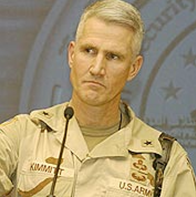

Danish and Icelandic troops have uncovered a cache of 36 shells buried in the Iraqi desert, and preliminary tests showed they contained a liquid blister agent, the Danish military said Saturday.
The 120mm mortar shells are thought to be left over from the eight-year war between Iraq and neighboring Iran, which ended in 1988, said U.S. Brig. Gen. Mark Kimmitt.
The shells were found by Danish engineering troops and Icelandic de-miners near Al Quarnah, north of the city of Basra where Denmark's 410 troops are based, the Danish Army Operational Command said in a written statement.
The shells were wrapped in plastic but had been damaged, and they appeared to have been buried for at least 10 years, the statement said.
It said British experts did a preliminary test and said the shells contained "blister gas," but did not elaborate.
Before the war, the United States alleged Iraq still had stockpiles of mustard gas, a World War I-era blister agent that is stored in liquid form. The chemical burns skin, eyes and the lungs.
U.S. intelligence officials also claimed Iraq had sarin, cyclosarin and VX, which are extremely deadly nerve agents.
"We're doing some preliminary tests to ensure that if they do contain any kind of blister agent that we can dispose of them properly," Kimmitt said.
The Danish military emphasized that the tests were not definitive. In the weeks after the Iraq war, the U.S.-led coalition found several caches that tested positive for mustard gas but later turned out to contain missile fuel or other chemicals.
Initial tests by field troops are designed to favor a positive reading, erring on the side of caution to protect soldiers. More sophisticated tests are often necessary.
Other discoveries early in the U.S.-led occupation turned out to be old caches that had already been tagged by United Nations inspectors and were scheduled for destruction.
Saddam Hussein's regime used chemical weapons against Iranian soldiers during that war and killed an estimated 5,000 Kurdish civilians in a chemical attack on the northern city of Halabja in 1988.
After the first Gulf War in 1991, a U.N. resolution called for the destruction of all Iraqi nuclear, chemical and biological weapons, as well as missiles with a range of more than 93 miles. The resolution set up a U.N. inspections commission to oversee the process.
The inspectors uncovered hidden nuclear and biological weapons programs in Iraq but found virtually nothing new after 1996. In 1998, Baghdad claimed it no longer had any banned weapons, accused the United States of spying and barred further inspections.
In 2002, President Bush accused Iraq of resurrecting its programs to develop weapons of mass destruction. After Bush called on the United Nations to pressure Iraq, Saddam agreed to let the inspectors return.
The inspectors worked for nearly four months but found no evidence of any of the weapons the Bush administration had alleged. Since the war, a nine-month search by a succession of U.S. teams has failed to find any current stockpiles of chemical, biological or nuclear weapons.
The lack of evidence has led critics to suggest the Bush administration either mishandled or exaggerated its knowledge of Iraq's alleged arsenal.
In October, Dutch marines found several dozen artillery shells dating from the 1991 Gulf War in the southern Iraqi town of Samawah, but the shells contained no biological or chemical agents. Samawah is 100 miles west of the southern region where the Danes discovered shells Saturday.
In April, U.S. troops found a dozen 55-gallon drums in an open field near the northern Iraqi town of Baiji.
Preliminary tests performed at the scene indicated one drum might contain the nerve agent cyclosarin and a blister agent that could be mustard gas. Tests later showed the barrel's contents were not chemical weapons.



















